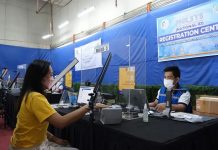A consultancy firm revealed on Wednesday there are no significant coral reefs identified within the study area for the proposed Samal Island-Davao City (SIDC) connector project.
The findings were based on the baseline coral assessment conducted by Galerio Environmental Consultancy (GEC) in the various Stations both in the Davao City and Samal sides.
GEC’s assessment debunked claims by the family who owns the property affected by the SIDC connector project who earlier said that the proposed bridge has ill effects on the white sand beach, rich sea life, and undersea flora and fauna. The Rodriguez family is making this contention as the basis of their appeal for a realignment of the landing site.
The family said they commissioned scientists Dr. Filipina Sotto, Dr. Cleto Nañola, and Joey Gatus to do a study of the ecosystem and biodiversity around the area of Paradise Reef, an area that will be hit by the bridge. Based on the study, there are three sites (stations) considered feasible for the landing site of the bridge: Lomos (station 1), Bridgeport (station 2), and the Paradise Island Beach Resort (PIBR, station 3).
Dr. Sotto’s team concluded that station 3’s Paradise Reef is home to rich marine life and corals preserved by the Rodriguez family as a de facto marine life sanctuary for almost 100 years.
For its part, GEC was hired by Ove Arup and Partners Hong Kong Ltd as its sub-consultant to collaborate in the preparation of the Environmental Impact Assessment (EIA) for the project including social aspects such as the conduct of public consultations and surveys.
The coral assessment covered seven stations with four sampling locations in Davao City and three sampling locations in the Island Garden City of Samal (IGaCoS). For the Davao City side, the location is in Barangay Hizon with stations 1 to 4, while in Samal is in Barangay Limao with 1 to 3 stations.
Diana Kristina Velasco, land use specialist of Galerio Environmental Consultancy, presented the results of the surveys conducted during the virtual public hearing on Monday. She said as a summary, the average living coral (20.2 percent) and the hard-coral cover (10.4 percent) in Barangay Limao is in poor condition based on the quartile index of reef health, soft coral condition is 23.4 percent, mean algal cover is 15.4 percent and mostly dead coral is covered with filamentous algae, other fauna such as sponges, sea anemone and ascidians were apparent.
“Based on this result, we can infer that most of the dead coral was translated into algal cover and biotic components suggesting that coral mortality was followed by the colonization of alga and no significant coral reefs identified within the study area,” she said.
Based on the survey conducted at Davao Station 1, there is an average hard cover in poor condition and soft corals still comprise a higher proportion compared to hard coral cover. For Davao Station 2, there is about eight percent of hard coral that belong to Acroporidae family and less of non-acropids and some life forms observed were massive such as Lobophylia, symphilia, and sub-massive Pocilopora; for Station 3, there were other conspicuous hard corals that were massive in the area such as porites, foliose, and encrusting montipora and also sponges are among dominant other fauna recorded in the survey; and Station 4, there is an average hard coral cover which is low and considered as in poor condition, whereas the LCC (live coral cover) is considered fair when the soft coral is also assessed, and other benthic attributes are other fauna such as sponges and gorgonian were also recorded.
For the IGaCoS stations: Station 1, which is the south of the proposed landing area, there is an average hard coral covered at 14.7 percent, which is considered as poor in condition, hard coral is slightly higher than the soft coral and other fauna such as sponges, sea anemone and ascidians were recorded; for Station 2, which is the nearest point at the landing area, soft coral has higher benthic proportion compared to hard coral and due to strong current, low profile but with massive porites, diploastrea and lobophyllia are abundant; and Station 3, which is the north of the proposed landing area, low relief corals were observed in patch reef with dominant massive porites and dead coral with algae (0.5 percent) and soft coral were recorded low (6.5 percent).
The samplings in Davao City and Samal were conducted on June 28 to 29, 2019 and December 6 to 7, 2019.
The proposed SIDC connector has a length of 3.98km (total roadway, including four ramps); and 2.85km (point to point length) and will be located at Barangays Vicente Hizon Sr., Angliongto and R. Castillo (Davao City side) and Barangay Limao in IGaCoS.






